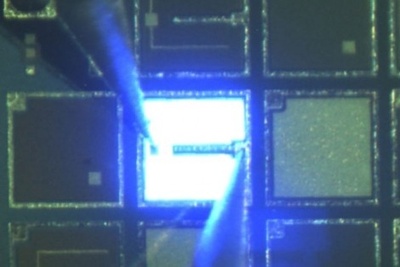UK-based Plessey readies for volume chip production, while Germany's Azzurro Semiconductors gains support for move to larger wafers.
 GaN-on-silicon LED
GaN-on-silicon LED
A disruptive approach to lowering the cost of solid-state lighting (SSL) with high-brightness LEDs appears to be gathering momentum, as two European companies invest to scale up the production of gallium nitride (GaN) emitters based on silicon substrates.
Conventionally, HB-LEDs are manufactured on top of either sapphire or silicon carbide material, because these crystals have a relatively close lattice match with the GaN structures that emit light.
But as the LED industry scales up to meet the twin challenges of cost reduction and more efficient light emission, the use of silicon substrates that can be more easily scaled to larger sizes is seen by many as an obvious way to cut chip costs.
The down side of the GaN-on-silicon method is that the light-emitting structures are based on materials with a poor crystal lattice match – meaning that LED chips fabricated in this way tend to have relatively poor performance.
Now UK-based Plessey Semiconductors, which has just taken delivery of a key piece of equipment used to make its first LEDs on a volume scale, along with Germany's Azzurro Semiconductors, US-based Bridgelux and China's Lattice Power are all aiming to challenge the established LED industry with the silicon-based approach.
Of the established industry, Osram Opto Semiconductors, Philips Lumileds and Samsung are all known to be working on the approach too – although their current production processes rely on the more traditional combination of materials.
Scaling up
Plessey will use its new metal-organic chemical vapor deposition (MOCVD) reactor from Aixtron to kick-start volume manufacturing at its 6-inch wafer facility in Plymouth, UK. Its novel process was initially developed at Cambridge University, before the historic semiconductor firm acquired the so-called "MAGIC" technology in February this year.
Meanwhile Azzurro, which is based in Dresden, last week received a grant worth €2.6?million from the local government of Saxony that will support a move by the company from 6-inch GaN-on-silicon wafer production to the larger 8-inch format – seen as a key transition that will unlock and economy of scale needed to rapidly reduce LED chip costs for lighting applications.
According to Plessey's HB-LED product line director Neil Harper, the UK firm's technology has one distinct advantage over that of its rivals. "We use a much thinner GaN layer, at only 2.5?microns compared to 6-8?microns in other GaN-on-silicon technologies," Harper explains. "This means less deposition time, so that we can do multiple production cycles in the reactor [every] 24?hours to achieve higher throughputs and lower costs."
Plessey says that the MOCVD reactor installation is just the first step in a multi-million-pound investment, in which it also intends to scale up to the larger 8-inch wafer format in the future.
The first LED samples produced by the UK firm emit in the blue region at 460 nm, although it has also made cyan (500 nm) and green (530 nm) emitters. By the end of this year, its initial white LEDs based on a phosphor-converted blue emitter are expected to deliver an efficacy of 80 lumens per Watt.
That performance level would lag the industry state-of-the-art by some distance, but by June 2013 an improvement to 150 lm/W is planned, with support from partners in both the UK and elsewhere in Europe.
Plessey is also aiming to integrate its "EPIC" (Electric Potential Integrated Circuit) sensor technology with the LED products. The sensors provide proximity and motion sensing, offering the potential to combine SSL with "smart" lighting to further improve energy efficiency.
Toshiba's stake in Bridgelux
Azzurro, which has worked closely with Osram Opto Semiconductors to develop GaN-on-silicon LEDs, is focused on supplying epiwafers to LED chip makers, and Stephan Lutgen, the company's VP of technology, said: "Based on the [Saxony government's] technology grant Azzurro can execute its strategic development of the 200 mm (i.e. 8-inch wafer) technology platform for power semiconductors and LEDs, and quickly attend to the strong customer demand."
California-based Bridgelux said in May that its technology development collaboration with Japan's Toshiba had expanded as the electronics giant took an equity stake in the Silicon Valley firm. The two had been working on 8-inch GaN-on-silicon wafer production, claiming to have produced a high-performance chip delivering a light output of 614 mW from a 1 W electrical input – though few further details were revealed.
In comparison, Osram OS announced earlier this year that its GaN-on-silicon LEDs had delivered an output of 634 mW and an efficacy of 127 lm/W from one of its own standard packages.
Last month, China's Lattice Power said that it had begun volume production of a new generation of GaN-on-silicon LED chips that would sharply reduce the cost of SSL. It plans to transfer production onto 150 mm (6-inch) substrates next year, according to the company's web site.





